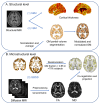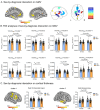Sex Differences in Depression: Insights from Multimodal Gray Matter Morphology and Peripheral Inflammatory Factors
- PMID: 39769178
- PMCID: PMC11677592
- DOI: 10.3390/ijms252413412
Sex Differences in Depression: Insights from Multimodal Gray Matter Morphology and Peripheral Inflammatory Factors
Abstract
Major depressive disorder (MDD) exhibits notable sex differences in prevalence and clinical and neurobiological manifestations. Though the relationship between peripheral inflammation and MDD-related brain changes is well studied, the role of sex as a modifying factor is underexplored. This study aims to assess how sex influences brain and inflammatory markers in MDD. We utilized voxel-based and surface-based morphometry to analyze gray matter (GM) structure, along with GM-based spatial statistics (GBSS) to examine GM microstructure among treatment-naive patients with depression (n = 174) and age-matched healthy controls (n = 133). We uncovered sex-by-diagnosis interactions in several limbic system structures, the frontoparietal operculum and temporal regions. Post hoc analyses revealed that male patients exhibit pronounced brain abnormalities, while no significant differences were noted in females despite their higher depressive scores. Additionally, heightened inflammation levels in MDD were observed in both sexes, with sex-specific effects on sex-specific brain phenotypes, particularly including a general negative correlation in males. Intriguingly, mediation analyses highlight the specific role of the parahippocampal gyrus (PHG) in mediating interleukin (IL)-8 and depression in men. The findings suggest that in clinical practice, it would be beneficial to prioritize sex-specific assessments and interventions for MDD. This includes recognizing the possibility that male patients may experience significant brain alterations, especially when identifying male patients who may underreport symptoms. Possible limitations encompass a small sample size and the cross-sectional design. In future research, the incorporation of longitudinal studies or diverse populations, while considering illness duration, will enhance our understanding of how inflammation interacts with brain changes in depression.
Keywords: IL-8; brain morphology; gray-matter-based spatial statistics; inflammatory factors; major depressive disorder; microstructure; sex difference.
Conflict of interest statement
The authors declare no conflicts of interest.
Figures






Similar articles
-
Gray matter structural alterations in first-episode drug-naïve adolescents with major depressive disorder: a comprehensive morphological analysis study.Psychol Med. 2025 Apr 11;55:e113. doi: 10.1017/S0033291725000790. Psychol Med. 2025. PMID: 40211094 Free PMC article.
-
Altered white matter volumes in first-episode depression: Evidence from cross-sectional and longitudinal voxel-based analyses.J Affect Disord. 2019 Feb 15;245:971-977. doi: 10.1016/j.jad.2018.11.085. Epub 2018 Nov 13. J Affect Disord. 2019. PMID: 30699883
-
Gray matter volume differences based on sex in first-episode drug-naive patients with major depressive disorder and its molecular analysis.Neuroreport. 2024 Dec 4;35(17):1117-1122. doi: 10.1097/WNR.0000000000002107. Epub 2024 Oct 10. Neuroreport. 2024. PMID: 39423325
-
A voxel-based meta-analysis comparing medication-naive patients of major depression with treated longer-term ill cases.Neurosci Biobehav Rev. 2023 Jan;144:104991. doi: 10.1016/j.neubiorev.2022.104991. Epub 2022 Dec 5. Neurosci Biobehav Rev. 2023. PMID: 36476776 Review.
-
Grey matter volume abnormalities in the first depressive episode of medication-naïve adult individuals: a systematic review of voxel based morphometric studies.Int J Psychiatry Clin Pract. 2021 Nov;25(4):407-420. doi: 10.1080/13651501.2020.1861632. Epub 2020 Dec 22. Int J Psychiatry Clin Pract. 2021. PMID: 33351672
Cited by
-
Long-term risk of late-life depression in widowed elderly: a five-year follow-up study.BMC Geriatr. 2025 May 19;25(1):351. doi: 10.1186/s12877-025-06028-y. BMC Geriatr. 2025. PMID: 40389894 Free PMC article.
References
MeSH terms
Substances
Grants and funding
LinkOut - more resources
Full Text Sources
Medical

